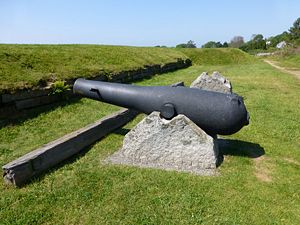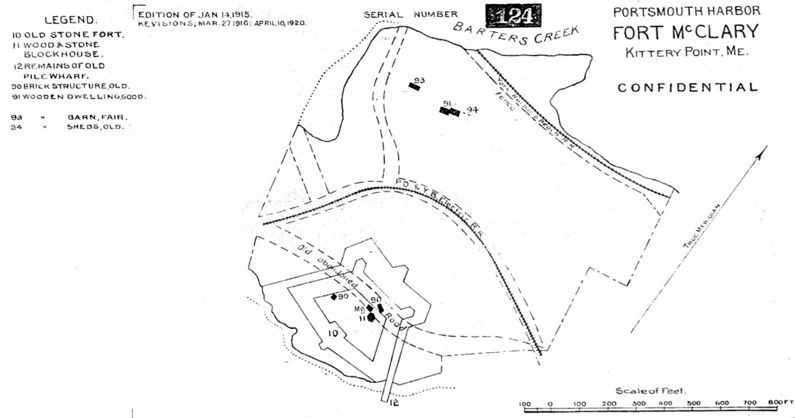Fort McClary: Difference between revisions
John Stanton (talk | contribs) No edit summary |
John Stanton (talk | contribs) No edit summary |
||
| Line 21: | Line 21: | ||
{{Clr}} | {{Clr}} | ||
<gallery> | |||
</gallery> | |||
== [[Endicott Period]] (1890-1910) == | == [[Endicott Period]] (1890-1910) == | ||
| Line 61: | Line 64: | ||
* [http://www.maine.gov/cgi-bin/online/doc/parksearch/search_name.pl?state_park=&historic_site=38 Fort McClary State Park] | * [http://www.maine.gov/cgi-bin/online/doc/parksearch/search_name.pl?state_park=&historic_site=38 Fort McClary State Park] | ||
* [http://www.fortmcclary.org/ Friends of Fort McClary] | * [http://www.fortmcclary.org/ Friends of Fort McClary] | ||
{{Visited| | {{Visited|20 Jun 2012}} | ||
=={{PAGENAME}} Picture Gallery== | =={{PAGENAME}} Picture Gallery== | ||
| Line 85: | Line 88: | ||
[[Category:Endicott Period Forts]] | [[Category:Endicott Period Forts]] | ||
[[Category:Must See]] | [[Category:Must See]] | ||
[[Category: | [[Category:2012 Research Trip]] | ||
Revision as of 13:28, 6 July 2012
Fort McClary (1808-1918) - An Second System Coastal Fort first established in 1808 on Kittery Point in York County, Maine. Named for Major Andrew McClary, who died in 1775 at the Battle of Bunker Hill during the Revolutionary War. Abandoned in 1918.
 |
 |
 | |
 | |
Second System (1808-1816)
Built as a stone and wood blockhouse with external batteries 1808-1809 on the site of previous fortifications including Fort William (3).
Third System (1816-1867)

Proposed to be upgrade to a full Third System fort by Brig. Gen.Joseph G. Totten, Chief Engineer of the United States Army. The fort was to work in conjunction with Fort Constitution (2) to guard the entrance to Portsmouth harbor. Construction began in 1863 but was curtailed soon after the end of the U.S. Civil War. The partially complete walls can be seen today.
The Third System fort was constructed as an irregular pentagon with three sides and two bastions to the rear and two sides facing the water. A caponier was centered between the two walls facing the water. The original blockhouse, the magazine and a barracks were among the structures at the center of the new fortifications. Protection was provided for both the land side and the sea side. The walls were never completed above the first tier and modifications in the form of earthworks were built as temporary protection.
Endicott Period (1890-1910)
Part of the Harbor Defense of Portsmouth, New Hampshire.
Three 15" Rodman smoothbore cannons were emplaced during the Spanish-American War as a temporary defense. These smoothbore cannons were still emplaced as late as 7 Dec 1903.
| Battery Click on Battery links below |
No. | Caliber | Type Mount | Service Years | Battery Cost | Notes |
|---|---|---|---|---|---|---|
| Battery Unnamed | 3 | 15" SB | Rodman Iron Carriage | 1898-190? | $ ? | In place 7 Dec 1903 |
| Source: CDSG | ||||||

World War I (1917-1918)
Equipped as an observation post during World War I and closed in 1918 at the end of the war.
Current Status
Part of Fort McClarey State Historic Site on Kittery Point, York County, Maine. Partially completed walls remain with cut granite stone blocks scattered about. Buildings on the site include the refurbished blockhouse, magazine and the shell of the Rifleman's house. Foundations of the second Rifleman's house and the barracks are exposed.
|
{"selectable":false,"width":"500"} |
Location: Fort McClary State Historic Site, York County, Maine. Maps & Images Lat: 43.0831445 Long: -70.7089412 |
Sources:
- Roberts, Robert B., Encyclopedia of Historic Forts: The Military, Pioneer, and Trading Posts of the United States, Macmillan, New York, 1988, 10th printing, ISBN 0-02-926880-X, page 367
- Weaver, John R. II, A Legacy in Brick and Stone: America Coastal Defense Forts of the Third System, Redoubt Press, McLean, 2001, First Printing, ISBN 1-57510-069-X, page 81
- Coast Defense Study Group, CDSG Press, CDSG Digital Library
Links:
- North American Forts - Fort McClary
- North American Forts - Fort McClary Main Page
- Wikipedia - Fort McClary
- Fort McClary State Park
- Friends of Fort McClary
Visited: 20 Jun 2012
Fort McClary Picture Gallery
|
Click on the picture to see a larger version. Contribute additional pictures - the more the better! |